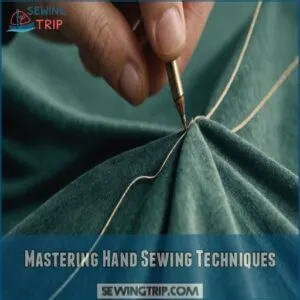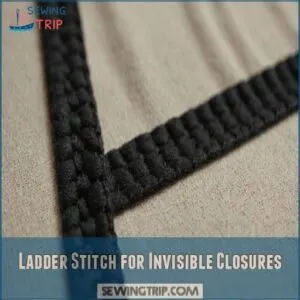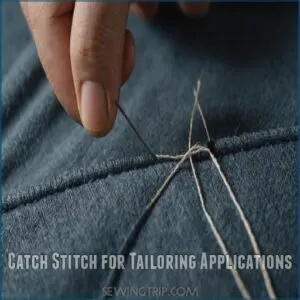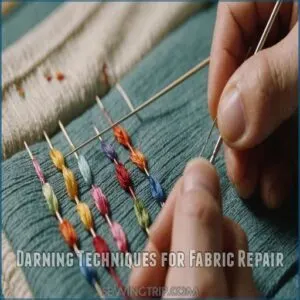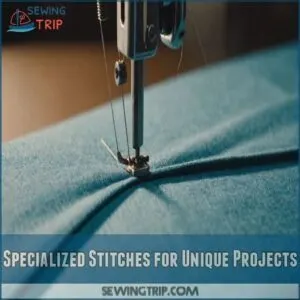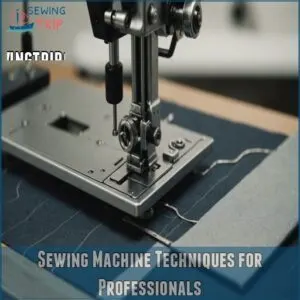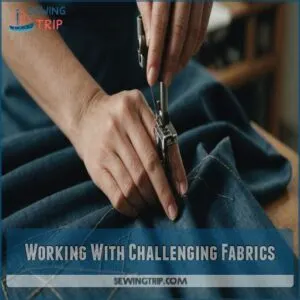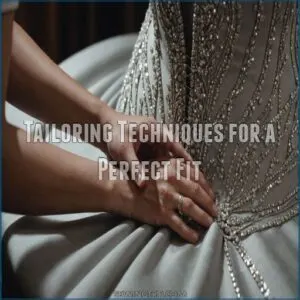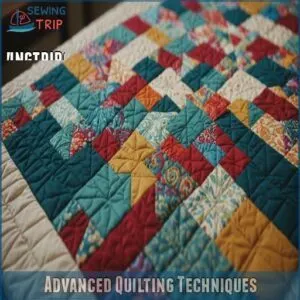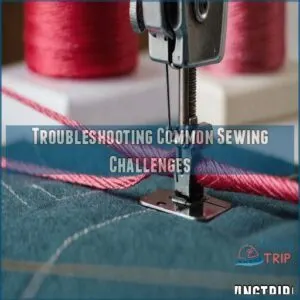This site is supported by our readers. We may earn a commission, at no cost to you, if you purchase through links.
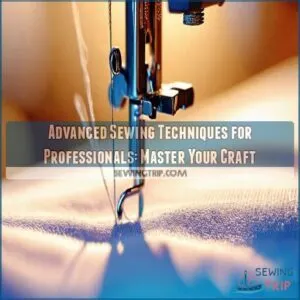
Explore specialty presser feet and tension adjustments – your sewing machine will become an extension of your creative vision.
From tailoring tricks that’ll make garments fit like a glove to quilting techniques that’ll have your projects singing, you’re in for a treat.
And just wait until you see how these skills can transform your troubleshooting abilities – those pesky sewing gremlins won’t stand a chance!
Table Of Contents
- Key Takeaways
- Mastering Hand Sewing Techniques
- Advanced Stitches for Professionals
- Specialized Stitches for Unique Projects
- Sewing Machine Techniques for Professionals
- Working With Challenging Fabrics
- Creating Professional Finishes
- Tailoring Techniques for a Perfect Fit
- Advanced Quilting Techniques
- Troubleshooting Common Sewing Challenges
- Frequently Asked Questions (FAQs)
- Conclusion
Key Takeaways
- You’ll master advanced stitches like French seams and ladder stitches to create couture-quality finishes, essential for working with delicate fabrics and achieving professional results by building on foundational skills such as basic hand stitches and mastering essential sewing techniques.
- You can transform your sewing projects by selecting the right tools – from specialized presser feet and thimbles to proper needles and threads that match your fabric’s unique requirements.
- You’ll need to adapt your techniques when working with challenging materials – adjust tension settings for knits, use stabilizers for delicate fabrics, and choose appropriate interfacing for structure.
- You can elevate your tailoring skills through precise fitting techniques, including princess seams, draping, and custom pattern adjustments that ensure garments fit perfectly.
Mastering Hand Sewing Techniques
You’ve likely experienced the frustration of threading a needle and tying a secure knot, only to have things unravel right at the finish line.
Mastering these hand sewing techniques will turn you into a pro.
With the right needles, threads, and tools at your fingertips, you’ll sew with precision and ease.
While giving your fingers a well-deserved break with thimbles and finger guards.
Threading a Needle With Precision
Threading a needle with precision might seem like a small hurdle, but it can save you time and headaches.
First, choose a needle size matching your thread thickness and eye size.
A good light source helps.
Hold the needle steady, with a relaxed hand position.
Place the thread end close and poke it through—like aiming for a bullseye in darts.
Tying Secure Knots for Stitches
Ever fumbled through tying knots while stitching? You’re not alone!
Mastering knot types, from single to double, guarantees your stitches hold firm.
Focus on knot placement for neatness, and remember, tension control is key to knot security.
Try knotless starts for a smooth finish.
Hand sewing techniques are like a magic trick—mastering basic stitches like the running stitch for beginners that includes a simple in-and-out stitch used for quickly gathering fabric or making temporary seams is crucial, practice makes perfection, and every stitch counts!
Selecting Needles and Threads for Projects
Imagine this: the perfect needle and thread combo can make your project sing!
Needle sizes are the magic wand for different fabric types, ensuring stitch choice and tension are spot on.
Opt for thicker threads for heavy-duty fabrics or delicate threads for finer materials.
Exploring thread weights is like discovering a secret spice rack for your sewing ventures!
Choosing Scissors and Cutting Tools for Accuracy
Because precise cuts are key, choose your sewing tools wisely!
Sharp scissors are essential; different scissors types excel with various fabric layers.
A rotary cutter and cutting mat are game-changers for straight lines.
Maintaining blade sharpness is vital for clean cuts.
Remember, investing in quality sewing tools is an investment in your craft.
These professional sewing methods will elevate your work!
Protecting Fingers With Thimbles and Finger Guards
When it feels like your fingers have more holes than Swiss cheese, it’s time to grab some thimbles and finger guards.
These handy sewing tools keep your fingertips safe from pesky needle pricks.
Whether you choose metal or leather thimbles, or silicone guards, each offers unique features.
Prioritize stitching safety and enjoy your sewing projects without the ouch factor!
Advanced Stitches for Professionals
When you’re ready to take your sewing skills to the next level, mastering advanced stitches is like adding a secret sauce to your sewing toolkit.
From French seams that keep delicate fabrics in check to darning techniques that breathe new life into well-loved garments, these stitches will have you sewing like a pro in no time.
French Seams for Delicate Fabrics
French seams are a must for delicate fabrics, giving you a refined finish every time.
With a little patience, you’ll avoid those fabric-fraying nightmares.
To master these seams, remember:
- Choose the right thread to match fabric weight.
- Avoid puckering with gentle tension.
- Press seams between steps for a crisp look.
Happy sewing!
Ladder Stitch for Invisible Closures
Imagine this: you’ve got a perfect project, but the seam’s got to vanish like magic.
Enter the ladder stitch—a hand sewing wonder for invisible closures. It’s all about weaving a thread ladder that nobody notices, like a ninja seamstress.
Great for invisible zippers and sewing machine alternatives, it’s the ultimate trick for closing seams neatly!
Catch Stitch for Tailoring Applications
Got a tricky seam to secure?
The trusty catch stitch is your go-to for an invisible finish!
This versatile sewing technique shines in tailoring, offering robust support while remaining discreet.
Grab your hand sewing tools and master this stitch to enhance your garment making techniques!
Imagine the joy of perfect seams, all because you dare to innovate.
Buttonhole Stitch for Custom Details
Ever thought about buttonholes as tiny windows of opportunity?
Embrace the buttonhole stitch to add unique flair to your projects.
With countless buttonhole stitch variations and tools, you can elevate your sewing skills.
Hand-stitching techniques, such as those used for couture hand-sewn buttonholes, offer a unique and durable finish that’s perfect for thick fabrics or when adding a couture touch.
Mastering buttonhole stitch placement and incorporating techniques like the saddle stitch guide for working with leather, practice guarantees professional sewing tips shine through.
Remember, advanced sewing techniques like these keep your creations stylishly secure, and your imagination’s the only limit.
Darning Techniques for Fabric Repair
So, you’ve mastered buttonholes? Awesome! Now, let’s tackle those pesky fabric tears.
Darning techniques are your secret weapon for patching holes and repairing damaged clothes.
It’s like magic, but with needles! You’ll become a fabric repair superhero.
- Learn invisible darning for seamless fixes.
- Master embroidery darning for decorative repairs.
- Use darning needles for precision.
- Practice different darning techniques for various fabric tears.
Specialized Stitches for Unique Projects
You’ve probably mastered the basics, but now it’s time to explore specialized stitches that make your unique projects stand out.
Custom embroidery, quilted layers, or smocked textures are some examples of specialized stitches.
These techniques add flair and also give your creations that professional touch, ensuring they impress everyone from beginners to seasoned sewers.
Embroidery Stitches for Embellishment
After mastering those professional stitches, let’s explore embroidery stitches for embellishment.
They’re the icing on the cake of your sewing project.
Embellishment techniques, like freehand embroidery, transform plain fabric into stunning art.
Experiment with stitch variations for unique designs.
Whether adding flair to a jacket or creating appliqué masterpieces, embroidery stitches bring your vision to life, injecting creativity and personality.
Quilting Stitches for Layered Fabrics
Imagine this: you’re knee-deep in a quilting project, layers of fabric neatly stacked.
Choosing the right quilting stitch types can make or break your masterpiece.
Experiment with stitch density to make sure your creation isn’t too stiff or floppy.
Use quality quilting tools to navigate tricky fabric choices.
Remember, sometimes hand sewing adds that personal touch machines can’t replicate in quilting.
Appliqué Techniques for Fabric Application
Appliqué techniques can add flair to your projects with hand-appliqué or machine appliqué options.
Get creative with free-motion styles and explore different appliqué types to personalize your pieces.
Picking the right fabric is important—prepare fabrics carefully to make sure they blend seamlessly.
Whether hand sewing or using a machine, let your artistic side spark some amazing designs!
Smocking Stitches for Texture and Gathering
Dive headlong into the enchanting world of smocking stitches for exquisite texture and gathering.
To achieve professional results, utilizing high-quality Professional Sewing Supplies is essential.
You’re about to transform fabric into art with these simple steps:
- Choose your pattern: From basic to intricate smocking techniques.
- Master your tools: Needles, threads, and smocking tools Professional Sewing Tools.
- Let history guide you: Explore the rich smocking history for inspiration.
Sewing Machine Techniques for Professionals
You’ve threaded your sewing machine, but trust me, true mastery starts when you harness the magic of presser feet and stitch tension to achieve flawless results, especially when serging thick layers requires careful adjustments to presser foot pressure and stitch width.
As you explore these advanced techniques, you’ll find quilting and embroidery as easy as your morning coffee, adding a professional touch to every project.
Mastering Presser Feet for Specific Tasks
So, you’ve mastered those fancy stitches!
Now, let’s talk presser feet.
They’re your secret weapons for different tasks.
A zipper foot makes installing zippers a breeze; the buttonhole foot creates perfect buttonholes every time.
Don’t forget the blind hem foot for those invisible hems and the walking foot for even feeding of multiple layers.
Experiment with presser feet types – you’ll become a sewing superstar!
Adjusting Tension for Smooth Stitches
After mastering presser feet, let’s tackle tension adjustments for silky-smooth stitches.
Imagine tension like seasoning—too little or too much, and it’s all off.
Adjust your machine’s tension settings based on fabric types, stitch length, and needle size.
Pay attention to bobbin tension too.
Troubleshooting issues? Listen to your machine’s hum; it often whispers what’s wrong.
Controlling Straight Stitches for Accuracy
Getting the hang of controlling straight stitches boosts your sewing accuracy dramatically. It’s like a secret sauce!
For spot-on results, remember:
- To master advanced sewing techniques, start by reading through entire patterns before starting a project, as recommended by resources like pattern reading guides. Adjust sewing machine settings diligently.
- Maintain consistent stitch consistency for even seams.
- Mark your seam allowance precisely—don’t wing it!
- Balance fabric tension carefully to avoid puckers.
This comfort leads to professional, polished results!
Exploring Specialty Feet for Quilting and More
Ever wondered how to nail free-motion quilting?
Specialty feet are your secret weapon!
The walking foot handles thick quilts, while the zipper foot sneaks into tight spaces.
Try the piping foot for stylish edges or the buttonhole foot for perfect closures.
With these trusty tools, your sewing projects will leap from plain to professional faster than you can say "bias tape"!
Working With Challenging Fabrics
When you’re tackling challenging fabrics, whether it’s slippery silk or stubborn denim, knowing the right techniques makes all the difference.
Let’s face it, even seasoned pros sometimes wish fabric had an instruction manual, but with a few tips up your sleeve, you’ll turn any tricky material into a sewing triumph.
Managing Delicate Fabrics With Care
Have you ever felt like your sewing machine has a mind of its own?
Let’s tame it and move on to managing delicate fabrics with care.
Selecting the right fabric type and mastering hand sewing techniques can be magical.
Remember, pre-washing prevents unwanted shrinkage.
Use pressing techniques gently, and choose seam finishes wisely.
Storage tips? Keep ’em fresh and wrinkle-free!
Sewing Thick Fabrics With Ease
Sewing thick fabrics can feel like wrestling a bear.
But don’t worry, you’ve got this!
To make it easier, check out tips on how to sew something thick(how to sew something thick) that include adjusting your machine settings and using the right tools.
- Fabric selection matters: Pick durable needles and threads.
- Mind those seam allowances: Go for 1/2-inch to 5/8-inch to keep it strong.
- Machine settings are your allies: Adjust stitch length and pressure.
Master these, and thick fabrics become your new best friend!
Working With Knit and Stretch Fabrics
Many knit fabric types require special handling.
Use a ballpoint needle to prevent skipped stitches when sewing knit seams.
Stretch fabric techniques, like using a walking foot, help prevent puckering.
Remember, patience is key!
Mastering these techniques transforms your projects from frustrating to fabulous.
For princess seams or French seams in stretchy fabrics, a zigzag stitch adds flexibility.
Enjoy the process of working with knits!
Preparing Fabrics for Professional Results
Preparing fabrics sets the stage for sewing like a boss. Start with fabric pre-washing to avoid shrinkage surprise parties. Align grain lines for smooth sewing. Use pressing techniques to flatten wrinkles, not your enthusiasm. Stabilize with interface when needed for stubborn fabrics. Take these steps to make sure your final product is as polished as a pro’s portfolio.
- Fabric pre-washing
- Grain alignment
- Pressing techniques
- Fabric stabilization
Creating Professional Finishes
You’re just a few steps away from creating professional finishes that give your projects a polished edge, like adding closures that won’t pop open at the worst possible moment.
With techniques like binding and interfacing, you’ll be able to transform the way your creations look and feel—because nobody wants their handmade masterpiece to scream "homemade disaster.
Binding and Facing for Clean Edges
Think edges, like the trim of a grand cake.
To achieve crisp lines, consider binding and facing.
Binding techniques hug edges tightly, while facing options add structure discreetly.
Fabric choices affect results.
Try hand sewing a blanket stitch for flair.
Consult sewing guides for tips.
Table time!
| Binding Techniques | Facing Options | Project Examples |
|---|---|---|
| Bias Binding | Sewn Facing | Necklines, Hemlines |
| Edge Binding | Fused Facing | Sleeves, Armholes |
| Self-Binding | Hidden Facing | Aprons, Skirts |
Interfacing and Stabilizing for Structure
You know that feeling when a project needs the perfect touch?
Interfacing and stabilizing do just that by adding structure and oomph!
Here’s what you need to know:
- Interfacing types: Choose fusible or sew-in, depending on the fabric.
- Stabilizing knits: Prevents stretching.
- Application techniques: Each fabric has unique needs.
Adding Closures and Fasteners With Ease
Imagine a perfectly sewn garment, ready for its grand reveal.
But wait—it’s missing closures!
Adding flawless zipper installations, perfect button placement, and secure hook and eye fasteners makes all the difference.
Don’t forget snap fasteners and magnetic closures for convenience.
Mastering these techniques transforms projects into professional wonders, like giving your work a cherry on top—snap, click, done!
Creating Custom Labels for Professional Touch
Velcro may secure a project, but custom labels seal your brand’s story.
Swap generic tags for branding labels that reflect your style.
Consider label design and placement – a perfectly printed label transforms a handmade craft into a professional marvel.
To take your professional finishes to the next level, invest in high-quality Tailoring Equipment Accessories.
Whether through DIY sewing or burgeoning sewing industry trends, your creation gains that added touch with the right label materials.
Tailoring Techniques for a Perfect Fit
Ready to transform your sewing skills?
This section on tailoring techniques will teach you how to create garments that fit like a dream,
so get ready to ditch those ill-fitting clothes forever!
Creating Princess Seams for a Flattering Fit
Just nailed that perfect finish, haven’t you? Now, let’s sculpt those curves with Princess seams for a fit that flatters like no other. Embrace the beauty of seam placement—here’s how:
- Choose fabric wisely: Tailors often recommend woven materials.
- Align patterns perfectly: Measure twice, cut once.
- Explore variations: Switch up necklines for style and comfort.
Working With Corset Making Techniques
You’ve nailed princess seams; now let’s embrace corset magic.
Corset construction begins with precise pattern drafting—think of it as solving a delightful puzzle.
Boning techniques add structure, while mastering shaping techniques guarantees a snug, comfy fit.
Handle hand sewing challenges with finesse, keeping thread and tools handy.
Corset fitting could surprise you, offering both confidence boosts and new sewing skills!
Mastering The Art of Draping and Shaping
Imagine sculpting with fabric—that’s mastering the art of draping and shaping.
You use draping techniques to refine your garments, giving them form and flair.
Fabric manipulation becomes your secret weapon for creating stunning silhouettes.
With practice, pattern drafting enhances your design precision, ensuring each piece fits like a glove.
Embrace the craft, and watch your sewing skills transform!
Creating a Customized Fit With Ease
As you refine your draping skills, take the leap into creating a customized fit.
Grab your tape measure, because body measurements are your best friend.
Invest in quality Pattern Making Tools to help you achieve precision and accuracy.
Use fitting adjustments and pattern alterations to tweak every seam.
Don’t forget ease allowance—it’s the secret sauce for comfort!
Fabric choice also plays a huge role; trust me, it’s worth the extra thought.
Advanced Quilting Techniques
In advanced quilting, you’re not just piecing together fabric; you’re creating art with layers, intricate patterns, and a bit of batting magic.
Tackle complex designs and free-motion techniques with the same gusto you’d have when tackling that heap of laundry—it might seem challenging, but the results are stunningly rewarding.
Creating Complex Quilting Patterns
Ever felt overwhelmed creating complex quilting patterns?
Fear not! Start by exploring quilting blocks for inspiration.
Get started with pattern design by sketching ideas with a splash of creativity.
Carefully handle fabric selection to make sure colors blend harmoniously.
Finally, master piecing techniques to bring your vision to life.
Remember, with patience and practice, you’ll quilt masterpieces in no time!
Working With Layered Fabrics and Batting
So, you’ve mastered complex quilting patterns? Fantastic! Now, let’s tackle layering fabrics and batting.
Proper layering techniques are key; consider fabric weight and batting selection.
Choose batting that complements your fabrics.
Experiment with stitching density for different textures.
Remember, a little extra care goes a long way in creating a beautiful, professional-looking quilt.
Happy quilting!
Mastering Free-Motion Quilting Techniques
You’ve tackled layered fabrics and batting, now let’s explore creative magic with free-motion quilting!
Achieving smooth curves and intricate designs doesn’t have to be a tall order.
To master this technique, remember that controlling speed through tension is key, as it allows you to move through curved motifs and star motifs smoothly.
Here’s how:
- Set up your quilting machine for good tension.
- Choose stitch variations that spark joy.
- Experiment with creative ideas for flair.
- Relax and enjoy the process; your quilt’s your canvas!
Creating Custom Quilting Designs With Ease
Crafting custom quilting designs opens up a fantastic world of creativity.
As you master free-motion quilting, let your imagination lead the way.
Experiment with quilting patterns that reflect your unique style.
Think about fabric selection – it’s like choosing the right paint for a masterpiece.
Don’t be afraid to draw inspiration from everyday life.
Each quilt tells a story, so make it personal!
Troubleshooting Common Sewing Challenges
Even the most skilled sewers occasionally face snags like tangled threads or shifting fabric, but don’t worry—you’re not alone!
With these expert fixes, you’ll tackle those common sewing headaches in no time, saving both your sanity and your fabric stash.
Dealing With Tangled Thread and Knots
While mastering quilting stitches is like painting a masterpiece, tangled threads and knots can mess up the canvas!
To keep your creative flow, focus on thread management and effective knot prevention.
Adjusting thread tension is key.
When you hit a snag, don’t stress—unraveling knots is part of the process.
With smart tangle solutions, you’ll stitch smoothly!
Preventing Fabric P
A stitch in time saves nine, right? But preventing pesky fabric pilling is key.
Start with fabric pre-washing—it’s like a spa day for your cloth.
Use seam finishes to keep edges in check, and master your ironing techniques for a crisp look.
Choosing the right supplies, such as matching fabric, thread, and needle for the best performance Learn more about Choosing the Right Supplies, is also important.
Choose threads wisely; they’re the backbone!
Frequently Asked Questions (FAQs)
What is the difference between basic and advanced sewing techniques?
Mastering basic sewing techniques is crucial, as it lays the groundwork for more complex projects, and involves selecting the right tools, such as choosing the right sewing machine types. Basic sewing techniques cover essentials like straight stitches and simple seams.
They’re like going from painting by numbers to creating a masterpiece – more complex but stunning results!
Advanced techniques, like French seams and invisible zippers, elevate your projects.
What are the different sewing techniques?
Sewing techniques range from basic to advanced.
You’ll start with straight stitches and progress to French seams, piping, and invisible zippers.
Each technique adds a unique touch to your projects, elevating your skills and creations.
Ready to thread that needle?
How can I improve my sewing skills?
Practice makes perfect, but persistence pays off.
You’ll boost your sewing skills by tackling challenging projects, mastering new techniques, and learning from mistakes.
Don’t be afraid to experiment – that’s how you’ll truly grow as a seamster.
Why should you read professional sewing techniques for designers 3rd edition?
You’ll elevate your design game with this book.
It’s a goldmine of pro techniques, from couture tricks to industry secrets.
You’ll be stitching like a fashion guru in no time.
It’s your ticket to sewing stardom!
What are some advanced sewing techniques?
Elevate your craft with these advanced sewing techniques: French seams for delicate fabrics, piping for elegant details, and invisible zippers for a polished look.
Flat felled seams, princess seams, and quilting to create professional-quality garments and home decor.
What are the strongest sewing techniques?
Flat felled seams and French seams stand out as powerhouse techniques.
They’re like the superheroes of sewing, creating strong, durable finishes.
Master these, and you’ll be stitching up garments that can withstand anything life throws at them.
What are the 10 types of sewing professionals?
Take Anna Wirth, who went from home sewing to launching her own couture house.
The sewing world spans costume designers, pattern makers, alterations specialists, bridal experts, theatrical costumers, fashion designers, sample makers, tailors, seamstresses, and textile artists.
How can I make my sewing more professional?
Master French seams and invisible stitching to polish your work.
You’ll want to invest in quality tools, understand fabric properties, and practice couture techniques.
Remember, precision‘s your best friend in professional sewing.
How to create and use custom sewing patterns?
You’ll start by sketching your design, measuring carefully, and drafting a paper pattern.
Next, create a muslin test garment.
Adjust for fit, and transfer your corrections to create your final custom pattern.
Techniques for adding structure to garments?
Ready to give your garments that professional edge?
Add interfacing to collars and cuffs, use boning in bodices, incorporate shoulder pads, and master dart manipulation.
These techniques create sophisticated, well-structured pieces you’ll love wearing.
Incorporating couture embellishments into professional designs?
Take your designs up a notch by hand-stitching delicate beadwork, adding French lace appliqués, or incorporating silk ribbon embroidery.
These elegant touches transform ordinary garments into stunning, high-end fashion pieces worth premium prices.
Efficient methods for mass production sewing?
Streamline your production by setting up organized workstations, using batch cutting techniques, and implementing efficient assembly lines.
Master chain piecing and invest in industrial equipment to boost your output while maintaining quality standards.
Adapting historical sewing techniques for modern projects?
Like texting a Victorian seamstress, you’ll blend old-school techniques with modern flair.
Master hand-stitched French seams and traditional buttonholes, then apply these timeless methods to create unique, contemporary pieces with historical charm.
Conclusion
You’ve learned, you’ve practiced, and you’ve grown – these advanced sewing techniques for professionals are now yours to master.
From delicate French seams to complex quilting patterns, you’re equipped to tackle any project that comes your way.
Remember, every stitch builds your expertise, and every challenge makes you stronger.
Keep experimenting, stay curious, and watch your creations evolve.
Your journey to professional-level sewing is just beginning, and the possibilities are endless.

